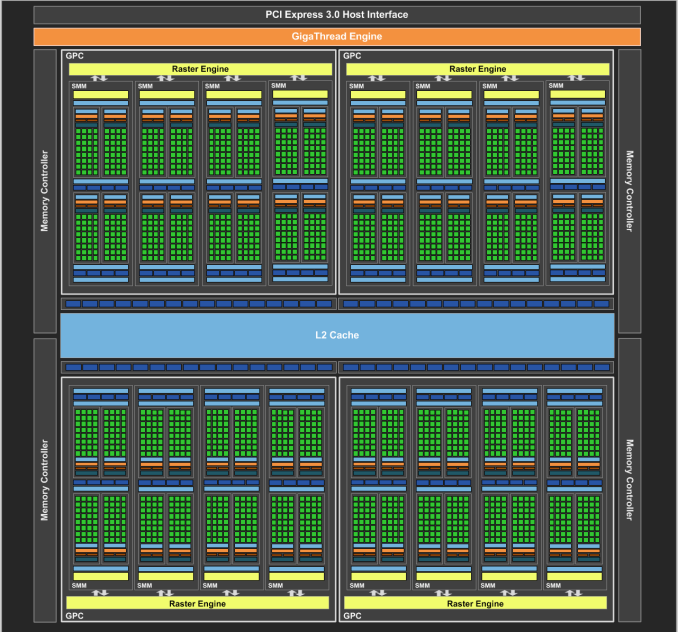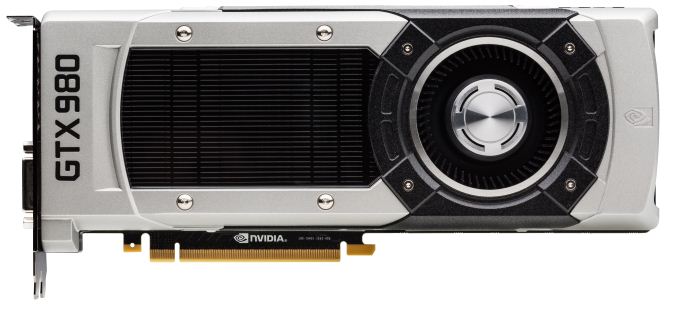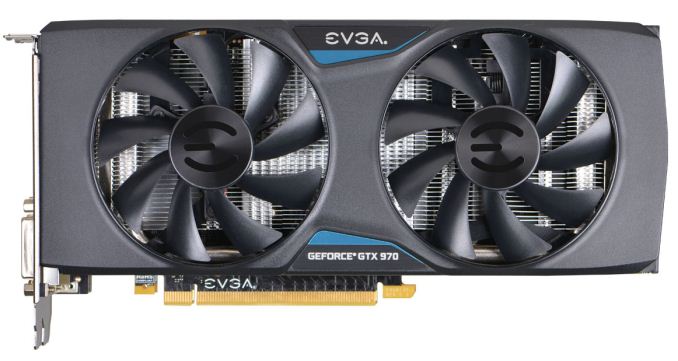The NVIDIA GeForce GTX 980 Review: Maxwell Mark 2
by Ryan Smith on September 18, 2014 10:30 PM ESTLaunching Today: GTX 980 & GTX 970
Now that we’ve had a chance to take a look at the architectural and feature additions found in Maxwell 2 and GM204, let’s talk about the products themselves.
Today NVIDIA will be launching 2 products. These are the GeForce GTX 980 and GeForce GTX 970. As with past 80/70 parts this is a two tier launch, with GTX 980 being NVIDIA’s new flagship card and 1st tier GM204 card, while GTX 970 offers 2nd tier performance at much lower pricing.
| NVIDIA GPU Specification Comparison | ||||||
| GTX 980 | GTX 970 (Corrected) | GTX 780 Ti | GTX 770 | |||
| CUDA Cores | 2048 | 1664 | 2880 | 1536 | ||
| Texture Units | 128 | 104 | 240 | 128 | ||
| ROPs | 64 | 56 | 48 | 32 | ||
| Core Clock | 1126MHz | 1050MHz | 875MHz | 1046MHz | ||
| Boost Clock | 1216MHz | 1178MHz | 928Mhz | 1085MHz | ||
| Memory Clock | 7GHz GDDR5 | 7GHz GDDR5 | 7GHz GDDR5 | 7GHz GDDR5 | ||
| Memory Bus Width | 256-bit | 256-bit | 384-bit | 256-bit | ||
| VRAM | 4GB | 4GB | 3GB | 2GB | ||
| FP64 | 1/32 FP32 | 1/32 FP32 | 1/24 FP32 | 1/24 FP32 | ||
| TDP | 165W | 145W | 250W | 230W | ||
| GPU | GM204 | GM204 | GK110 | GK104 | ||
| Transistor Count | 5.2B | 5.2B | 7.1B | 3.5B | ||
| Manufacturing Process | TSMC 28nm | TSMC 28nm | TSMC 28nm | TSMC 28nm | ||
| Launch Date | 09/18/14 | 09/18/14 | 11/07/13 | 05/30/13 | ||
| Launch Price | $549 | $329 | $699 | $399 | ||
Starting with the GeForce GTX 980, this is a fully enabled GM204 part. This means that 16 SMMs are enabled (2048 CUDA cores), as are all 64 ROPs and the full 256-bit memory bus. It is in other words GM204 at its best.
For clockspeeds NVIDIA is shipping GTX 980 with a base clockspeed of 1126MHz, a boost clockspeed of 1216MHz, and in our samples we have found the maximum clockspeed (highest stock boost bin) to be 1252MHz. This is a higher set of clockspeeds than any NVIDIA consumer GPU thus far, surpassing GTX 770, GTX Titan Black, and GTX 750 Ti. Curiously NVIDIA’s self-defined (and otherwise arbitrary) boost clock is much higher than on past parts; normally it would only be 50MHz or so above the base clock. This indicates that NVIDIA is getting more aggressive with their boost clock labeling and are picking values much closer to the card’s maximum clockspeed. This is a subject we will be revisiting later.
Meanwhile the memory clock stands at 7GHz, the same as with NVIDIA’s past generation of high-end cards. With GDDR5 clockspeeds all but tapped out, NVIDIA appears to have reached the limits of GDDR5 as a technology, hence their long-term interest in HBM for future architectures and improved color compression for current architectures. In any case this 7GHz of GDDR5 is attached to a 256-bit memory bus, and is populated with 4GB of VRAM. NVIDIA for the longest time has held to 2GB/3GB of memory for their cards, so it is a welcome sight to see that they are now making 4GB their standard, especially if they are going to target 4K gaming.
For power delivery GTX 980 has a rated TDP of 165W. This is significantly lower than the 250W TDPs of the GTX 780/780Ti/Titan and even the 225W TDP of the GTX 770, and heavily contributes to NVIDIA’s overall power efficiency advantage. Meanwhile NVIDIA does not specify an idle TDP, however in our testing idle power usage is lower than ever for a high-end NVIDIA card, indicating that NVIDIA should have it down to the single watt range.
Moving on, we have the GTX 980’s lower price, lower performance counterpart, the GTX 970. Compared to GTX 980, GTX 970 drops 3 of the SMMs, reducing its final count to 13 SMMs or 1664 CUDA cores. It also sheds part of a ROP/L2 cache partition while retaining the 256-bit memory bus of its bigger sibling, bringing the ROP count down to 56 ROPs and the L2 cache down to 1.75MB, a configuration option new to Maxwell.
As expected, along with the reduction in SMMs clockspeed is also reduced slightly for GTX 970. It ships at a base clockspeed of 1050MHz, with a boost clockspeed of 1178MHz. This puts the theoretical performance difference between it and the GTX 980 at about 85% of the ROP performance or about 79% of the shading/texturing/geometry performance. Given that the GTX 970 is unlikely to be ROP bound with so many ROPs, the real world performance difference should much more closely track the 79% value, meaning there is a significant performance delta between the GTX 980 and GTX 970. Elsewhere the memory configuration is unchanged from GTX 980. This means we’re looking at 4GB of GDDR5 clocked at 7GHz, all on a 256-bit bus.
GTX 970’s TDP meanwhile is lower than GTX 980’s thanks to the reduced clockspeeds and SMM count. The stock GTX 970 will be shipping with a TDP of just 145W, some 80W less than GTX 770. NVIDIA’s official designs still include 2 6-pin PCIe power sockets despite the fact that the card should technically be able to operate on just one; it is not clear at this time whether this is for overclocking purposes (150W would leave almost no power headroom) or for safety purposes since NVIDIA would be so close to going over PCIe specifications.
Due to the launch of the GTX 980 and GTX 970, NVIDIA’s product lineup will be changing to accommodate these cards. GTX 780 Ti, GTX 780, and GTX 770 are all being discontinued; their replacements offer better performance at better prices for lower power consumption. GTX 980 will be launching at $550, meanwhile GTX 970 will be launching at the surprisingly low price of $329, some 40% cheaper than GTX 980. On a historical basis GTX 980 is a bit higher than most of the past GTX x80 cards – which are often launched at $500 – while GTX 970 immediately slots in to GTX 770’s old price.
NVIDIA’s target market for the GTX 900 series will be owners of GTX 600/500/400 series cards and their AMD equivalents. GTX 980 and GTX 970 are faster than their 700 series predecessors but not immensely so, and as a result NVIDIA does not expect 700 series owners to want to upgrade so soon. Meanwhile 600 series owners and beyond are looking at 70%+ improved performance for cards at the same tier, along with some degree of a reduction in power consumption.
For today’s launch NVIDIA will be doing a reference launch of the GTX 980, so reference cards will be well represented while production of customized cards ramps up. Meanwhile GTX 970 is a pure virtual launch, meaning there will not be any reference cards at all. NVIDIA’s partners will be launching with customized designs right away, many of which will be carried over from their GTX 600/700 card designs. This will be a hard launch and cards should be readily available, and while NVIDIA should have no problem producing GM204 GPUs on the very mature TSMC 28nm process, it is difficult to predict just how well supplies will hold out.
On the competitive basis NVIDIA’s direct competition for the GTX 980 and GTX 970 will be split. GTX 980 is an immediate challenger for the Radeon R9 290X, AMD’s flagship single-GPU card which outside of a couple of sales continues to be priced around $499. GTX 970’s competition meanwhile will be split between the Radeon R9 290 and Radeon R9 280X. From a performance perspective the R9 290 is going to be the closer competitor, though it's priced around $399. Meanwhile the R9 280X will undercut the GTX 970 at around $279, but with much weaker performance.
NVIDIA for their part will not be running any promotions or bundles for the GTX 900 series, so what you see is what you get. Otherwise AMD will have their continuing Never Settle Forever bundle in play, which offers up to 3 free games in order to add value to the overall product.
Finally, there will be price cuts for the GTX 700 series. Officially GTX 760 stays in production with a new MSRP of $219. Meanwhile GTX 770, GTX 780, and GTX 780 Ti will go on clearance sale at whatever prices retailers can manage, and are still part of NVIDIA’s Borderlands bundle offer. That said, from a performance and power efficiency angle, the GTX 900 series is going to be a much more desirable product line.
| Fall 2014 GPU Pricing Comparison | |||||
| AMD | Price | NVIDIA | |||
| Radeon R9 295X2 | $1000 | ||||
| $550 | GeForce GTX 980 | ||||
| Radeon R9 290X | $500 | ||||
| Radeon R9 290 | $400 | ||||
| $330 | GeForce GTX 970 | ||||
| Radeon R9 280X | $280 | ||||
| Radeon R9 285 | $250 | ||||
| Radeon R9 280 | $220 | GeForce GTX 760 | |||













274 Comments
View All Comments
Laststop311 - Saturday, September 20, 2014 - link
I'm going to wait for the custom gtx 980's. It was already throttling from reaching the 80C limit on most games. Blower design wouldn't of throttled if they left the vapor chamber in but they didnt. My case has plenty of airflow so i don't require a blower design. MSI twin frozr V open air design will cool the gpu much better and stop it from throttling during gaming. People rushing to buy the reference design are missing out on 100's of mhz due to thermal throttle.chizow - Saturday, September 20, 2014 - link
Yep the open-faced custom coolers are definitely better at OC'ing, especially in single-GPU configs, but the problems I have with them are:1) they tend to have cheaper build quality than the ref, especially the NVTTM cooler which is just classy stuff. The custom coolers replace this with lots and lots of plastic, visible heatpipes, cheapo looking fans. If I wanted an Arctic Accelero on my GPUs I would just buy one.
2) they usually take longer to come to market. Frequently +3-6 weeks lead time. I know its not a super long time in the grand scheme of things, but I'd rather upgrade sooner.
3) The blowers tend to do better in SLI over longer periods of time, and also don't impact your CPU temps/OC as much. I have a ton of airflow too (HAF-X) but I still prefer most of the heat being expelled from the start, and not through my H100i rad.
4) Frankly I'm not too worried about squeezing the last 100-150MHz out of these chips. There was a time I might have been, but I tend to stick it to a safe OC about 100-150MHz below what most people are getting and then call it a day without having to do a dozen 3DMark loops to verify stability.
Laststop311 - Sunday, September 21, 2014 - link
Did you see the benchmarks. Some games were running in the 900's some in the 1000's some in 1100's. Stuck at these frequencies because the card was riding the 80C limit. As the review mentioned these aren't the same titan coolers as they removed the vapor chamber and replaced it with regular heatpipes. Getting a custom cooled card isnt about squeezing the last 100-150 from an OC its about squeezing an extra 400-600 mhz from an OC as many reviewers have gotten the gtx 980 to OC to 1500mhz. We are talking a massive performance increase from getting the proper cooling bigger than even the r9 290x going from reference to custom and that was pretty big itself.Laststop311 - Sunday, September 21, 2014 - link
Even to get the card to reliably run at stock settings during intense gaming you need a custyom cooled card. The reference cooled card can't even reliably hit its stock clock under intense gaming because the blower cooler without vapor chamber sucks.chizow - Sunday, September 21, 2014 - link
No, you can adjust the Nvidia fan and GPU temp settings to get sustained Boosts. There is a trade-off in terms of fan noise and/or operating temps, but it is easy to get close to the results of the custom coolers at the expense of fan noise. I personally set my fan curve differently because I think Nvidia's 80C target temp profile is a little bit too passive in how quickly it ramps up fanspeeds. I don't expect to have any problems at all maintaining rated Boost speed, and if I want to overclock, I fully understand the sacrifice will be more fan noise over the custom coolers, but the rest of the negatives regarding custom coolers makes the reference cooler more appealing to me.venk90 - Thursday, September 18, 2014 - link
The GTX 980 page on NVIDIA website seems to indicate HDMI 1.4 as it says 3840*2160 at 30 Hz over HDMI (it is mentioned as a foot note). Are you sure about it being HDMI 2.0 ?Ryan Smith - Thursday, September 18, 2014 - link
Yes. I've confirmed it in writing and in person.vegitto4 - Thursday, September 18, 2014 - link
Hi Ryan, great review! There will be the usual HTPC perspective? For example, did they fix the 23.976 refresh rate as Haswell does? I think it's important to know how these work as htpc cards. RegardsRyan Smith - Thursday, September 18, 2014 - link
For this article there will not. These cards aren't your traditional HTPC cards. However we can possibly look into it for next week's follow-up.chizow - Friday, September 19, 2014 - link
I think the definition of HTPC is beginning to change though, and while these may not yet fit into traditional HTPC (Brix and NUC seem to be filling this niche more), they are definitely right in the SteamBox/BattleBox category.Honestly, SteamBox was the first thing that came to mind when I saw that 165W TDP on the GTX 980, we will be seeing a lot of GM204 variants in the upcoming years in SFF, LAN, SteamBox and gaming laptop form factors that is for sure.